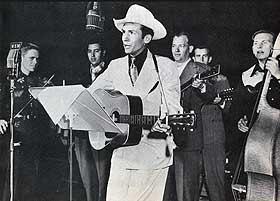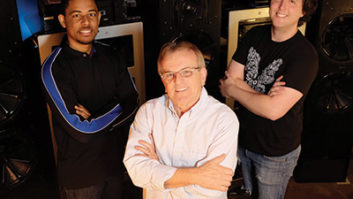
In 1951, Hank Williams was at the peak of his talent and his star power, and fans could hear him on the radio every morning at 7:15 on WSM-Radio’s Mother’s Best Flour Show, promoting baking products and playing a selection of country, standard and gospel tunes. Williams made all of these 15-minute programs over the course of a year, bringing his band into the radio studio whenever they were off the road. If Williams had lived and worked to a ripe old age, these performances from the Golden Age of radio would still be worth preserving. But because Williams died at 29, the Mother’s Best performances are rare and precious.
The masters remained in WSM vaults for years until the radio station moved to another location. An employee helping with the move rescued the acetates —72 programs survived—and in 1981, Bob Pinson of the Country Music Hall of Fame wisely made flat-transfers of the recordings.
In the ’90s, the masters were given to Jett Williams, Hank Williams’ daughter, and after a long legal battle between Williams’ estate and his former label (MGM, now part of Universal) over the rights, Williams’ estate was able to begin revealing these treasures to the public.
Joe Palmaccio, working out of his studio, The Place…for Mastering, was brought onboard first to restore and master songs for a three-CD box titled Hank Williams: The Unreleased Recordings (2008, Time Life). “At that time, we assessed the state of the acetates and compared them to the tapes made in ’81; the originals were in really bad shape,” Palmaccio says. “They had been handled too much. The sound on the tapes was much better.”
The tapes also became Palmaccio’s source material for Gospel Keepsakes (2009). But it was not until this past September that Time Life released The Complete Mother’s Best Recordings: a 15-CD set containing all of the surviving original broadcasts, beginning to end. “This is the ‘über set,’” Palmaccio says. “We presented the shows chronologically, the best we could tell, with no editing from the needle drop to the end of the last song.
“From a technical standpoint,” Palmaccio continues, “it’s important to note that I started over. Despite all the work I’d done on Unreleased and Gospel, I went back to zero because I had since adopted some of the Cube-Tec technology and I knew we wouldn’t have sonic continuity if I stuck in the things I’d already done.”
Palmaccio says the restoration work was “massive: lots of material, all of it was noisy, but there were varying degrees of noisiness. On some of it you’d hear the bacon-frying noise, but it was relatively good, considering the source. On other ones, the noise was as loud as his voice.
“There were common problems like the edges of the discs would be noisier because that’s where they were handled. The inside cuts, of course, were more distorted because that’s the nature of recordings that are made on flat discs: As you go to the inner diameter, the fidelity decreases. The quality varied, and there wasn’t any one piece of software or any one thing I could do to make it all go away.
“So I approached it kind of the way an archeologist dusts off dirt, one layer at a time, using three main tools,” Palmaccio continues. “I used a Sequoia workstation as my main editor, and I would start with the Sequoia spectral-cleaning tool, which can take out large individual ticks or pops. Sometimes an auto program can leave artifacts, and I was trying to avoid that at all costs.
“Then I would use the Algorithmix ScratchFree Pro program. That’s a combination declicker and decrackler, each of which you can set up separately. Depending on the damage, I could use that up to three times, taking little bits every time.”
All the while, Palmaccio was keenly aware of how important it was to maintain the presence of Williams’ voice. “[Williams historian] Colin Escott, Jett Williams and I felt we heard a part of his voice we’d never heard before,” Palmaccio says. “He’s generally considered kind of a nasal singer, but in this group of recordings there’s a lot of chest tone in his voice. My rule was that as soon as the denoise process stepped on that, I backed away.
“After I went through those passes, I got into the Cube-Tec stuff, using a combination of declicker, decrackler, descratcher and Spectral Dehiss. I didn’t use all of them every time, or at the same time, but one thing that was kind of a miracle worker was the Spectral Dehiss. There wasn’t any hiss to speak of, but when we would take out all the clicks and pops, we were left with flat surface noise, and spectral could take just enough of that surface noise off. His voice was so forward then. It was like taking away the smudges or glare on a picture.
Next, Palmaccio played the restored shows back on a Steinberg WaveLab workstation into a Lavry MDA24 D/A converter so that he could EQ the recordings in his custom analog mastering console. “That was done mostly with an SPL PQ mastering equalizer. The other two pieces that were important were the Weiss EQ1 linear phase EQ and the Weiss DS1 Mk3 dynamics unit. Once I had it sounding the best I could, I would record that into Sequoia, where I would do my final editing, level tweaks, sequencing, references and create the production masters.
“These weren’t high-tech recordings,” Palmaccio says. “When they made them, no one ever planned on hearing them again. But there’s something incredibly charming and sublime about the performances.”
At a price of $199, this miraculous-sounding set may be out of reach even for many serious fans, but anyone can stream one complete program at ,a href=”http://www.hankwilliamsmothersbest.com” target=”_Blank”>www.hankwilliamsmothersbest.com.







